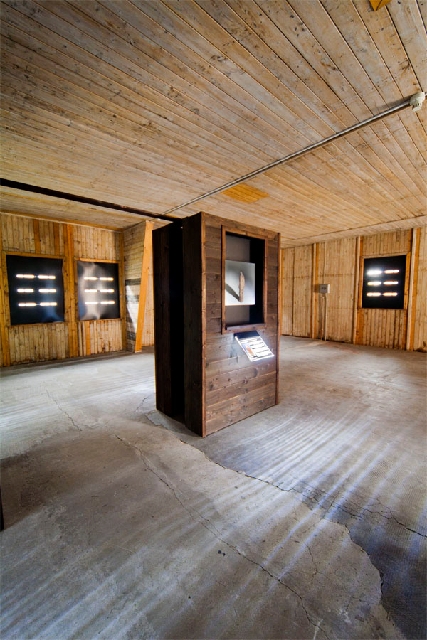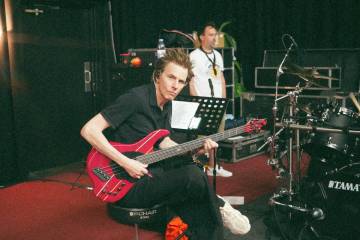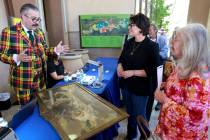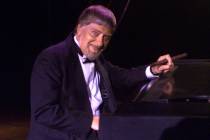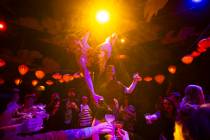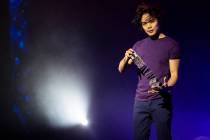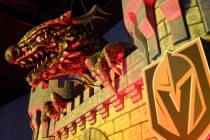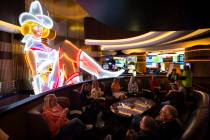Death camp prisoners’ art reflects strength of human spirit
They’re art objects of the type that can be found in just about any museum or gallery.
Portraits. Sketches. Caricatures. Sculptures. Pieces of various sorts that serve as tangible representations of whatever its creators were experiencing at a moment in time.
But what makes these particular pieces memorable — powerful, poignant, unsettling — is where and when they were created: at Auschwitz-Birkenau and other Nazi death camps, during the thick of World War II.
For that reason, the pieces represent more than the expression of an individual artist’s vision. They also serve as vivid testament to whatever unquenchable quality it is that compels human beings to seek out beauty and self-expression amid even the most horrible circumstances.
Through Feb. 20, Southern Nevadans may experience the power of art in a way they may not have before when “Forbidden Art,” a photographic exhibition from the Auschwitz Memorial in Poland, comes to Temple Beth Sholom in Las Vegas.
The exhibition features large-format photographs of 20 works of art created by prisoners at Auschwitz-Birkenau and other Nazi concentration camps and which now are part of the Auschwitz Memorial’s collections.
Its appearance here is sponsored by the Polish Consulate in Las Vegas in cooperation with the Jewish Federation of Las Vegas and Temple Beth Sholom. The exhibition’s national tour is sponsored by the Polish Mission of Orchard Lake, Mich.
John Petkus, honorary consul for the Republic of Poland in Las Vegas, said he has been working for about a year-and-a-half to bring “Forbidden Art” to Las Vegas.
The exhibition formally opened here Thursday with a reception that, Petkus said, the consul general of Poland in Los Angeles was scheduled to attend. After Las Vegas, the exhibition is scheduled to head to New York and Washington, D.C.
Petkus viewed “Forbidden Art” on one of its previous stops in the United States.
“When I saw it, I just instantly knew that this was something we needed to have here,” he said.
Many of the photos in the exhibition depict artwork made by prisoners at Auschwitz-Birkenau, the Nazi concentration camp in German-occupied Poland where more than 1 million people, most of whom were Jewish, were murdered.
Petkus called the artwork featured in the exhibition’s photographs “amazing.”
“For people to, under such horrible circumstances — losing their families, losing their homes, (experiencing) the fear of death every second — to still come out with this art ... is just amazing,” he said.
“It’s just amazing, the internal strength these people had. They wouldn’t give up on hope.”
In fact, Petkus added, “some of the art, you’d never believe in a million years somebody in Auschwitz did the art because it’s so uplifting. Some of the art shows camp life, but just the fact that people wanted to show their self-expression and would not give up is just amazing.”
Also attending Thursday’s opening was Piotr M.A. Cywinski, director of the Auschwitz-Birkenau State Museum. Petkus said Las Vegas is the only stop on the exhibition’s U.S. tour that Cywinski is scheduled to attend.
In an email, Cywinski said that, unlike at other concentration camps, the memorial at Auschwitz was established “quite early” after the war, “so many (art) objects could be found and saved.”
Also, Cywinski said, survivors of the camps often would “bring us ... such objects which they kept after the liberation. Among them, many pieces of art were found. This exhibit is the means to show some of them.
“Today, those artifacts show in a very moving way the deepest humanity of the prisoners — humans, who were deprived of fundamental humanity by ... Nazi Germany.”
The motivations the prisoners/artists had for creating art in the camps — even though their efforts could have resulted in punishment or even death — varied, Cywinski said.
For some, creating art was a way to “escape the reality of the camp,” he said, while others created art in “an attempt to record in a nonverbal form (their) camp experiences, (as) a kind of testimony.”
And, Cywinski said, works of art sometimes were created “in order to bribe or win someone in the camp hierarchy over or to exchange ... for some goods or food.”
Prisoners were forbidden to use camp materials in creating their art. Yet, Cywinski said, pencils, paper and other items could be obtained either on work assignments outside the camp or from people who were assigned to administrative jobs.
Obviously, Cywinski added, neither the possession of such materials nor using them to create art was permitted, and discovery “could result in very harsh punishment, including death.”
The types of pieces viewers will see in the exhibition’s photographs are diverse. Some can evoke hope, despair, fear or terror, Cywinski said, while others depict “camp scenes or are a complete escape into the world without camps.”
“One cannot look at those objects with the art connoisseur’s eyes,” he said. “This is not where one should search for their value, and this is not their fundamental meaning.”
Rather, Cywinski continued, the works “constitute a source of knowledge of those times” and “are probably the only trace left after those most difficult emotions to be expressed by people who were stripped of everything, condemned to death, being tormented and starved to the extremes.
“Through this art, they show us that despite the tragic conditions and almost complete lack of hope for freedom, they keep their dignity, they live, they do not give up till the very end. This is a very strong testimony.”
Some of the prisoner/artists whose works are represented in the exhibition survived the camps and were liberated, Cywinski said. “However, today very few of them are still alive. We live in the times when the last survivors are passing away.”
Petkus noted that “Forbidden Art” is particularly suited for showing at Temple Beth Sholom, because the synagogue already is home to a remembrance garden commemorating the Warsaw Ghetto Uprising.
For Rabbi Felipe Goodman of Temple Beth Sholom, the works of art shown in the photos offer proof that “even in their darkest hours,” the human spirit endures and that the Jewish people “were never fully broken by the Nazis.”
Contact reporter John Przybys at
jprzybys@reviewjournal.com
or 702-383-0280.
PREVIEW
What: "Forbidden Art"
When: 9 a.m. to 6 p.m. Monday through Thursday, 9 a.m. to 2 p.m. Friday, 9 a.m. to 1 p.m. Sunday
Where: Temple Beth Sholom, 10700 Havenwood Lane
Admission: Free (804-1333)




